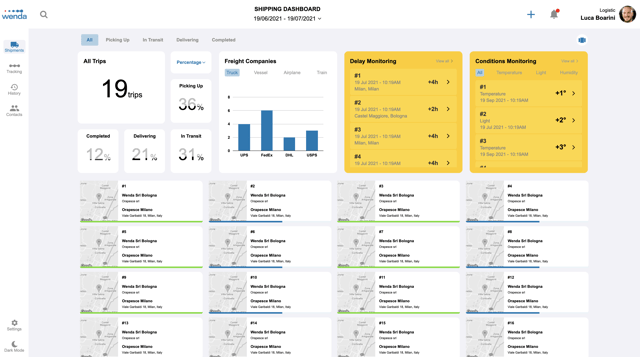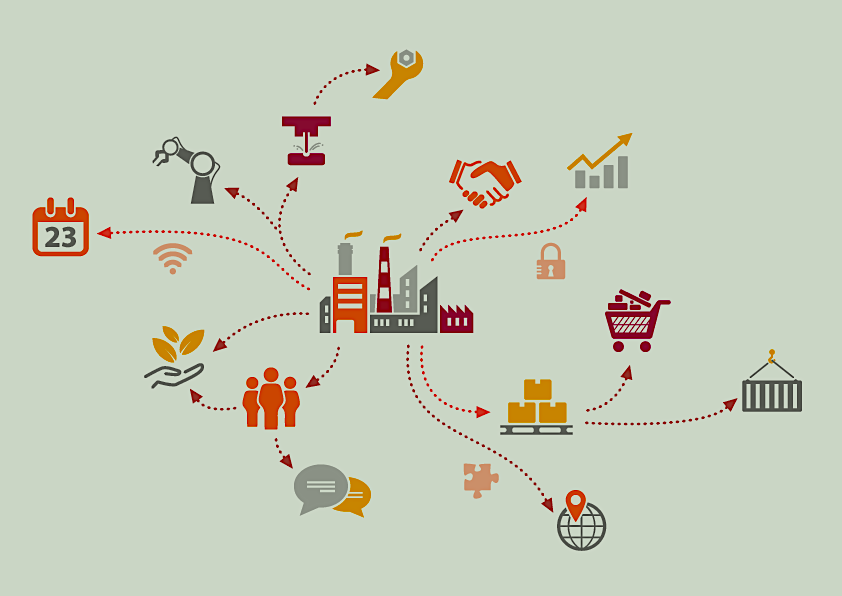The logistics and transportation sector, like many other industries in the current economic picture clouded by inflation and skyrocketing energy prices, is exploring various alternatives to contain costs, increase service levels and ensure an optimal customer experience.
Digital supply chain tracking solutions help companies reduce pressure on supply chains and provide an excellent framework for structuring efficient and flexible logistics.
Tracking capabilities and integrated logistics bring different benefits to companies – which can thus improve the management of their supply chains – and make it clear that efficient logistics today is necessarily rooted in the implementation of digital solutions for shipment and warehouse tracking, and innovative data-driven technologies.
The importance of traceability in all stages of the logistics flow
Traceability is the function employed by logistics and transportation companies to track processes, products and their inputs from the beginning of the supply chain to final consumption, obtaining granular information about products and processes. While product traceability ensures the accuracy of information including origin, composition, batch-lot and product condition data, process traceability ensures accurate information on location, status, milestones and other operational steps.
The goal of traceability is to perform advanced monitoring of shipments and possibly in real time, provide information on the history of product movements – including all changes to the chain of custody over time – and to be able to identify who is handling a given product at any given time: when traceability is assured, the exact location and condition of a specific unit of product can be derived, as well as the company (or business partner) that owns it.
Traceability has to do with generating data regarding the origin, location, and condition of the product, while transparency has to do with communicating this information. So, traceability focuses less on mapping the entire end-to-end supply chain and more on tracking certain groups of components or purchase orders as they move along the supply chain.
Traceability enables companies to provide better customer service, identify pain points, respond to changes in demand, effectively manage recalls, and certify sustainable products and processes. It supports risk management, brand protection and customer engagement along supply chain networks, and allows efficient logistics to be set up.
Product traceability, on the other hand, will minimize risks associated with product waste or loss. Detailed product information will increase operational efficiency through reduction in inventory of lost products, faster inventory turns, and, for temperature-sensitive products that must meet cold chain requirements, real-time condition monitoring. Action can then be taken well in advance to resolve disruptions or mitigate risks.
“Traceability enables companies to provide better customer service, supports risk management, brand protection and customer engagement along the supply chain.”

Tracking and integrated logistics: what are the benefits?
The term tracking refers to the ability to track the status of an order and check the location of a package, pallet, container in real time. Through it, delivery time forecasts can be made and customers kept informed. Classic tracking solutions usually follow the order preparation stages, transit stages, passage from the distribution center, and delivery.
Integrated logistics is a business management process that governs the flow of materials, information and goods from point of origin to point of arrival, in which all management activities are interconnected and interdependent. It is an innovative and highly collaborative approach to the management of the various phases that mark the transformation of an input into an output within the logistics process, and includes collaborators, partners and suppliers in the development of a system that allows each element – internal or external to the company – to communicate its status and the operations performed or scheduled in a rapid, secure and unambiguous manner. It is at this point that technological solutions intervene, enabling an input to be received, processed and transmitted to the system, where it will be integrated in real time with all other data from the rest of the supply chain.
“Integrated logistics is a business management process that governs the flow of information and goods, in which all management activities are interconnected.”
At the core of integrated logistics is data analytics, which typically leverages Big Data Analysis, Artificial Intelligence and Machine Learning technologies. In addition to ensuring the monitoring of shipments and the entire ecosystem in real time, it also enables the building of predictive models capable of optimizing production and distribution and acting proactively against unforeseen events and bottlenecks along the chain. Management and measurement in integrated logistics are thus activities that can be greatly simplified and automated, provided that an architecture is built and digital solutions are employed that ensure the integrity, speed and security of information flows.
Tracking and integration solutions adopted by logistics and transportation companies provide a number of benefits:
- Increased productivity: from production lines to delivery to the end customer, there is a generalized increase in productivity;
- Reduced costs: knowing logistics flows to perfection is essential for implementing improved processes and optimizing operations. All this results in the reduction of logistics costs;
- Increased competitiveness: companies that have a dynamic, fully monitored logistics flow with the lowest possible error rate are more competitive and ultimately can expand and successfully explore new markets;
- Inventory management optimization: product control is greatly improved when departments share all information, and the risk of overstock or shortage problems decreases;
- Data optimization: as a result of data unification, simplification and normalization, accessibility of information flows easier and faster;
- Customer retention: an optimal level of service and a fully satisfactory customer experience function as a differentiator and contribute substantially to building trust with customers.
The ideal tools for efficient logistics
We have seen the importance of traceability and the benefits that tracking and integrated logistics bring to supply chain companies that need advanced solutions for advanced shipment tracking. It is important to note that all of the best performing and therefore most necessary tools for companies wishing to set up efficient logistics are indeed digital solutions in which the software element is dominant. In the current extremely favorable climate for the digital transition, it is worth noting with McKinsey that the global SaaS (Software as a Service) market is currently worth about $3 trillion and estimates indicate that it could reach $10 trillion by 20301.
Let's quickly review the main systems used by logistics and transportation companies to track goods, products, processes and information:
- ERP (Enterprise Resource Planning): is software that allows the integration of information from multiple sources and areas of the company, such as sales, accounting, production, human resources and other departments.
- WMS (Warehouse Management System): is software that optimizes material flows within the warehouse. Every movement of goods is recorded in the WMS and transmitted to the ERP.
- TMS (Transport Management System): is software for managing transportation fleets; it is used to organize and plan the routes of vehicles and couriers.
The ultimate goal of companies should be to have a digital platform that is able to unify data from these systems, which is able to manage supply chain and logistics network data to execute and plan better actions, gain complete visibility of processes, make effective decisions, rationalize costs, mitigate risks, and improve service levels.
Conclusions
Improving supply chain management necessarily comes through the activation of traceability functions, which help companies respond quickly and efficiently to problems and unexpected events in the supply chain. Tracking solutions and integrated logistics enable logistics and transportation companies to achieve a number of benefits, chief among which are increased productivity and competitiveness. There is a clear emergence of the need to have a digital platform that is able to unify data from separate systems, so as to speed up shipment tracking processes and promote risk mitigation and overall cost reduction.
Notes
1. See the report by McKinsey titled The SaaS factor: Six ways to drive growth by building new SaaS businesses


